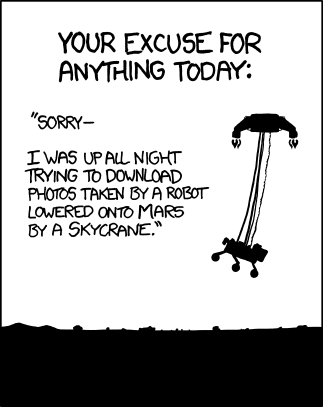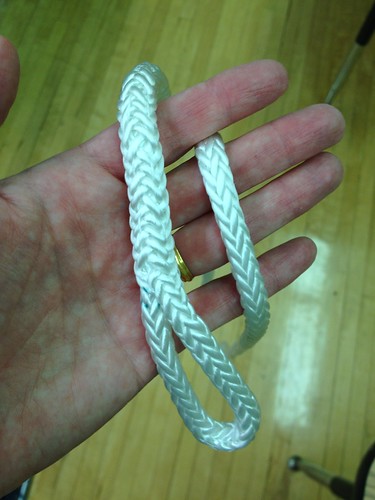 Astronomy Books for the Very Young
Astronomy Books for the Very Young
I think you can guess what spurred me to search out astronomy books appropriate for ages 0-2. That’s right, my daughter. Feel free to chime in with your favorites in the comments, but remember we’re talking about 0-2-year-olds here, so board books or simple text. Rhyming or rhythmic text is also good.
I was very unhappy when I found that the selection for 0-2-year-olds was quite limited. I liked several books out of what was available though. I’ve finished my first draft of a board book of my own, but until I find a publisher I’ll stick with recommending other people’s books.

Papa, Please Get the Moon for Me (Classic Board Book)
By Eric Carle — ISBN-13: 978-0689829598, Seattle Public Library, Amazon.
So far this is my daughter’s favorite of the books I got. I’m not surprised, because it’s by Eric Carle! I hesitate very slightly about recommending this one, because at the end it implies that the Moon actually changes size when it changes phase. But imagination is also important.
The board book has large flaps that are prone to being crunched by small hands. It’s a good book, anyway.
 The Sun Is My Favorite Star
The Sun Is My Favorite Star
By Frank Asch — ISBN-13: 978-0152021276, Seattle Public Library, Amazon.
I love this one. The story is good, the pictures are clean and bright. It’s accurate and pretty.
 Happy Birthday, Moon
Happy Birthday, Moon
By Frank Asch — ISBN-13: 978-0812448320, Seattle Public Library, Amazon.
Again, it’s an imaginative story, but stays correct in its scientific concepts. Moonbear can’t reach the Moon, but none-the-less is able to get the Moon a birthday present and give it. I think Frank Asch is one of my new favorite author-illustrators.
 Curious George and the Rocket (Board Book)
Curious George and the Rocket (Board Book)
By H.A. Rey — ISBN-13: 978-0618120697, Seattle Public Library, Amazon.
This is edited down from the non-board-book version (Curious George Gets a Medal), but somehow I don’t mind for this story. Monkeys always make a great story. And this one also has a countdown–lots of fun with the little ones.
 Countdown! With Milo (The Adventures of Milo and Mouse)
Countdown! With Milo (The Adventures of Milo and Mouse)
By Mike Austin — ISBN-13: 978-1609052089, Amazon.
I love it! It’s a countdown… I already said those are great, and the pictures have so many things to point at and find, and “buttons” to “push.” (It’s a plain flat board book, no real buttons).
 Space Station (Mini House Book)
Space Station (Mini House Book)
By Peter Lippman — ISBN-13: 978-0761115755, Amazon, but it’s out of print
I know, it’s out of print, so it isn’t fair for me to suggest it. This is a book and a toy. You open the pages to look through the space station. So far, in our house, it’s been less of a book and more of a toy–which is fine by me. Literacy at this age involves just being comfortable with books as well as spending time reading them. So, even if you can’t find this one, you can look up other Mini House books.
 Astronaut (Mini People Shape Book)
Astronaut (Mini People Shape Book)
By Giovanni Caviezel and C. Mesturini — ISBN-13: 978-0764162169, Amazon.
Another toy-book. I definitely got this one for the shape. The text is a bit advanced for right now, it’s pretty much a collection of factoids. Fun anyway.
 There’s No Place Like Space: All About Our Solar System Revised Edition (The Cat in the Hat’s Learning Library)
There’s No Place Like Space: All About Our Solar System Revised Edition (The Cat in the Hat’s Learning Library)
By Tish Rabe and Aristides Ruiz — ISBN-13: 978-0679891154, Seattle Public Library, Amazon.
I would be remiss if I didn’t talk about this book. Much to my surprise I liked it. If you don’t have a 0-2-year-old in your life right now you might think Cat in the Hat is great for young kids. A lot of the Seussian books are actually a bit advanced, and long for the 0-2 crowd. Toddlers are not quite ready for the puns; the rhyming and rhythm are great for them though. This book is good and accurate enough, the rhymes are fun. It is a “tour of the solar system” book, but it doesn’t harp on about getting through basic facts on each planet. It just goes through one or two cute topics for each. You might not read the whole book with your toddler in one sitting, but that’s okay.
![]()
~ A l i c e !
 Green Meteor Over Seattle
Green Meteor Over Seattle
There was a bright green meteor streaking through the western sky over Seattle a couple hours ago (midnight-thirty-ish local time). Check out West Seattle Blog’s continuing coverage to hear some first-hand accounts.
This was a bolide meteor (an exploding meteor/shooting star). It was part of the Quadrantid Meteor Shower. Read my article about why we see meteors below if you’re interested in some of the science behind that.
Also, why colors? The same reason different fuels burn with different colored flames: it depends on the chemicals in the fuel. Green is commonly produced by copper when conducting flame/fireworks color experiments here on Earth–doesn’t mean the fireball had any copper in it, that’s just a related piece of information. It is also true that our eyes are very bad at determining colors at night–so the green could just be an optical illusion and not related to the composition of the meteor.
![]()
~ A l i c e !
 My Favorite Maya Mythology and Astronomy
My Favorite Maya Mythology and Astronomy
You’ve already been hearing about how the ancient Maya didn’t predict the end of the world today, that’s just misinformation, so I thought I’d share some of my favorite accurate topics about the ancient Maya astronomy and mythology.
Dark Constellations
In western astronomy and western mythology we recognize constellations as dot-to-dot pictures made of stars. In other words, we make images out of “positive space” to use some art terminology. The ancient Maya are a completely different culture: several of their constellations are made of “negative space.” They recognize images in the dark spaces between the stars. Here is an enhanced image, you can easily see the llama across the middle (with a star for an eye), and the snake in the upper right-hand corner:
I always love to use this as an example of how “different cultures are different.” Just because we think dot-to-dot pictures are the “normal” way to do constellations doesn’t mean every other culture everywhere also thinks that.
Venus
The ancient Maya place extreme significance on the planet Venus. Their calculations of exactly when it will rise, set, first appear after sunset, last appear before sunrise rival even today’s computers. And they didn’t have computers. We should spend more time observing natural phenomena ourselves.
Calendar
Their calendar is AMAZING. It has cycles within cycles. There are several good java converters out there that show you how it works.
Also, when you see a picture of the “Maya Calendar” it should be laid out in a rectangle. If it is in a circle and looks like a compass rose it is most likely the Aztec Calendar. (If it looks like gears cycling within each other, it might be the Maya Calendar after all).
Sources
Aveni, Anthony. Skywatchers of Ancient Mexico (book)
![]()
~ A l i c e !
 Winter Solstice Sunset Watch – 2012 (NOT the end of the world)
Winter Solstice Sunset Watch – 2012 (NOT the end of the world)
It’s time for the 15th seasonal sunset watch!!
Also, no, the world isn’t ending, the planets aren’t aligning, gravity isn’t shifting. Go donate to your favorite science education or critical thinking organization in solidarity with scientific thinking.
- When: Friday, December 21 at 4:05pm (so come at 3:45pm)
- Actual sunset is supposed to be at 4:20pm, but at the summer solstice we noticed that the Sun set about 10 minutes earlier than the USNO says it does, so I’ve moved the time of our sunset watch up so we don’t miss it. Last autumn the timing seemed to line up correctly – what will it do this time?
- The equinox moment is at 3:12am… but we’re watching the sunset not the sunrise because of how the park lines up.
- Where: Solstice Park – all the way up the hill from the tennis courts (or, if you’re not in Seattle, wherever you have a view of the western horizon!)
- Who: Everyone welcome, as usual.
Come watch the winter solstice sunset at Solstice Park in West Seattle on Saturday the 22nd. We’ll see if the sunset lines up with the placed marker. I’ll be there even if it is cloudy because sometimes the Sun peeks through just as it begins to set, but if it is driving rain or sleet I’m staying home with some hot tea! This year I’ll be there NO MATTER THE WEATHER: ice, sleet, snow, pouring rain, or even (as unlikely as it might be) sunshine. I want to make sure you have someone to answer your 2012 questions.
If you’re interested – here’s the timing of various celestial events from Seattle, courtesy of the U.S. Naval Observatory Astronomical Applications Department:
Sun and Moon Data for One Day
The following information is provided for Seattle, King County, Washington (longitude W122.3, latitude N47.6):
Friday 21 December 2012 Pacific Standard TimeSUN
Begin civil twilight 7:19 a.m.
Sunrise 7:55 a.m.
Sun transit 12:08 p.m.
Sunset 4:20 p.m.
End civil twilight 4:57 p.m.MOON
Moonrise 12:01 p.m. on preceding day
Moonset 1:29 a.m.
Moonrise 12:26 p.m.
Moon transit 7:24 p.m.
Moonset 2:32 a.m. on following dayPhase of the Moon on 21 December: waxing gibbous with 66% of the Moon’s visible disk illuminated.
First quarter Moon on 19 December 2012 at 9:20 p.m. Pacific Standard Time.
This event is my part of the NASA’s Solar System Ambassador program, and thanks to West Seattle Blog for publicizing the last few!
Everyone is welcome, see you there!
![]()
~ A l i c e !
 Henrietta Swan Leavitt… and Dolls
Henrietta Swan Leavitt… and Dolls
Happy Ada Lovelace Day everyone!
Because my birthday was this past weekend, I wanted to tell you about one of the great women of astrophysics: Henrietta Swan Leavitt.
What does this have to do with my birthday? I can hear you asking that. See, my parents are wonderful, thoughtful, creative geeks. And they got me an American Girl doll for my birthday. (YES, my birthday this year. YES, I’m an adult). But then they dressed her up like Henrietta Swan Leavitt. She even has accessories!
(Reply to this post to vote for my parents to create a whole line of women scientist outfits for American Girls dolls! I sure do…)
My American Girl Woman
I was in transports of delight. Yes, my mother sewed those new clothes for her. (The skirt is leftover fabric from my prom dress oh so many years ago.). My father worked on the accessories:
- Light-box
- Magnifying glass (it works)
- Flyspankers (see paragraph 2: http://www.starwrite.org/harvard.html)
- Folio with “glass” plates of the Magellanic Clouds, Henrietta’s scientific paper on Cepheid Variables, and photographs
Henrietta Swan Leavitt
Henrietta Swan Leavitt made it possible for us to measure the size of the Universe.
Yup. read that again. Henrietta Swan Leavitt made it possible for us to measure the size of the Universe.
Ostensibly she was working as a “computer” (what women who did the computational or classification work in astronomy were called in those days) for Dr. Edward Pickering at the Harvard College Observatory.
It was there, rubbing elbows with other famous women of astrophsics like Annie Jump Cannon, as she was classifying the sizes of variable stars in the Magellanic Clouds that she discovered the period-luminosity relationship in Cepheid variable stars.
Variable stars are, as they sound, stars that vary in brightness. What Henrietta discovered, is that for Cepheid variables, the brightness of the star (luminosity) and the period (time between brightest moments) are related. The longer between “blinks” the brighter the star. This means that if you can see a star varying and time between the “blinks” you can figure out how bright that star actually is, not just how bright it looks. (Remember that farther away stars look dimmer, but if you got closer to them they’d look brighter).
By knowing how bright a star truly is, you can accurately measure the distance to that star by how dim it appears to be. Which means you can now measure the distances to things outside our galaxy.
Go read up some more… and let’s investigate the rest of those women computers from Pickering’s lab. Did they all make awesome discoveries? Margaret Harwood, Mollie O’Reilly, Edith Gill, Evelyn Leland, Florence Cushman, Marion Whyte, Grace Brooks, Arville Walker, Johanna Mackie, Alta Carpenter, Mabel Gill, and Ida Woods.
Want More?
*In case you’re curious, the doll is the newest historical American Girl: Caroline, with her hair pulled back in a bun.
Henrietta Swan Leavitt from the AAS
Links!
![]()
~ A l i c e !
 Fall Equinox Sunset Watch 2012
Fall Equinox Sunset Watch 2012
It’s time for the 14th seasonal sunset watch!!
- When: Saturday, September 22 at 7:00pm (so come at 6:45pm)
- Actual sunset is supposed to be at 7:09pm, but at the summer solstice we noticed that the Sun set about 10 minutes earlier than the USNO says it does, so I’ve moved the time of our sunset watch up so we don’t miss it. Last autumn the timing seemed to line up correctly – what will it do this time?
- The equinox moment is at 7:49am… but we’re watching the sunset not the sunrise.
- Where: Solstice Park – all the way up the hill from the tennis courts (or, if you’re not in Seattle, wherever you have a view of the western horizon!)
- Who: Everyone welcome, as usual.
Come watch the autumn equinox sunset at Solstice Park in West Seattle on Saturday the 22nd. We’ll see if the sunset lines up with the placed marker. I’ll be there even if it is cloudy because sometimes the Sun peeks through just as it begins to set, but if it is driving rain or sleet I’m staying home with some hot tea!
If you’re interested – here’s the timing of various celestial events from Seattle, courtesy of the U.S. Naval Observatory Astronomical Applications Department:
Sun and Moon Data for One Day
The following information is provided for Seattle, King County, Washington (longitude W122.3, latitude N47.6):
Saturday 22 September 2012 Pacific Daylight Time
SUN
Begin civil twilight 6:26 a.m.
Sunrise 6:57 a.m.
Sun transit 1:02 p.m.
Sunset 7:06 p.m.
End civil twilight 7:37 p.m.MOON
Moonset 10:48 p.m. on preceding day
Moonrise 2:45 p.m.
Moon transit 7:17 p.m.
Moonset 11:52 p.m.
Moonrise 3:31 p.m. on following dayFirst quarter Moon on 22 September 2012 at 12:41 p.m. Pacific Daylight Time.
This event is my part of the NASA’s Solar System Ambassador program, and thanks to West Seattle Blog for publicizing the last few!
Everyone is welcome, see you there!
![]()
~ A l i c e !
 Curiosity on Mars Memes
Curiosity on Mars Memes
I had to do it. I’m collecting memes about Curiosity’s landing on Mars. I’ll do my best to keep up, but I will probably fail soon, due to the viral and meme-y nature of the internet.

A joke made by many.
He’s his own meme now too.
http://whatstrending.com/2012/08/meet-mohawk-guy-nasa-mars-curiosity-livestream/

xkcd.
Not really a meme, but worth including.
Curiosity killed the cat.
http://www.quickmeme.com/meme/3qdanz/
http://www.quickmeme.com/meme/3qd993/
This post is a job for tumblr. Too bad I don’t have a tumblr account.
Funny, too many to post: http://www.quickmeme.com/Unimpressed-Curiosity/?upcoming
Here’s one:
http://blog.makezine.com/2012/08/05/sometimes-we-live-in-the-future/
From Boing Boing:
Maaaaaars?
MARS!
Marsmarsmarsmarsmarsmarsmarsmars …
You know how I said I was going to give up? Well, now it is time to give it up. I can’t keep up. :) It was fun anyway.
 Curiosity Lands on Mars!
Curiosity Lands on Mars!
There’s not much I can add to what’s already been said, so I’ll settle for answering a few questions brought up at tonight’s landing watch party and sharing some photos from our party as well as the first shots from Curiosity.
Your Questions, Answered
Is that really nylon rope?
Yes.
I was inspired by Emily Lakdawalla’s post about the “cables” used during the Sky Crane Maneuver to bring a sample to tonight’s party. She managed to get her hands on a piece of the cord that had been used during testing. The look and feel were identical to nylon rope, so I stopped by Home Depot to get 7.5 meters of nylon rope. I brought her photo along and bought the closest thing they had. It was pretty darn close: similar diameter, same color, braided (different braid pattern), nylon rope. You can see mine hanging from the ceiling in some of the party pictures below. This is a close-up of the real rope:

Emily Lakdawalla and Curiosity’s cable
Curiosity was lowered 7.5 meters on three of these cords. But is the cord really nylon like the rope I got at Home Depot? Yes. All the NASA websites say “nylon cable” or “nylon cord.” I can’t tell if they did anything special beyond the style of braiding, but the main material was definitely nylon.
One other difference: my rope was rated to support 194 pounds. NASA’s cords each needed to support at least a third of the rover’s total weight (1 ton), so a single rope needed to support 333 pounds. (Whoops. I’m living in a wishful world of metric.) 1 ton is 2000 lbs, not 1000. So a single rope would need to support 660ish pounds. Then I realized I don’t know if that 1 ton weight is on Mars or on Earth. Which matters quite a bit.
Curiosity weighs 2000 lbs on Earth, 750 lbs on Mars. So each cord will hold about 250 lbs. Still needs to be stronger than my rope.
How does the plutonium power the rover?
This rover is powered not by solar panels but by a “Radioisotope Power System.” Basically, nuclear power.
This doesn’t mean there’s a nuclear generator onboard. Rather there’s a small block of plutonium (specifically plutonium-238), which is slowly decaying into uranium-234 and eventually into lead. (Wait, don’t turn away just yet, I’ll explain!) As the plutonium decays it releases a good amount of heat because of that famous equation E=mc2. (I’m not going to give the lecture on radiation, nuclear power, and E=mc2 today, rather I’m going to skip straight to the heat part.)
How does the heat power the rover? There are these awesome devices called thermocouples which, when heated, create electricity. It’s the same effect that makes a plug-in cooler work, but for the cooler you’re doing the process backwards. You add electricity, and it makes the thermocouple cold on one side and hot on the other. Onboard Curiosity, the plutonium is warming up one side of the thermocouple, which makes electricity flow through the circuit.
That electricity is captured in batteries, and Curiosity runs off the batteries.
Curiosity’s First Photos
The first photos returned were simple low-resolution images from the hazard-avoidance cameras near the wheels of the rover. By low-resolution I mean LOW–way less than a megapixel, a mere 64 pixels by 64 pixels. And the sheer number of people trying to download that image brought NASA’s servers to their knees. (The livestream of the landing didn’t bring the servers down, just that first image …)
First photo-can you tell there’s a wheel there?
(You put your right wheel in, you put your right wheel out, you put your right wheel in and you shake it all about …)
Here are the “high resolution” photos we got a few minutes later (256px square)
Our Party
The Enevoldsen Interpretation Team
My dad, Keith, did way more for this event than I did. Recall all those Lego rover Rocker-Bogie mechanisms he made? Well, he kept going. Thanks, Dad!
Also, my brother, Nils, and husband, Jason, were on hand answering all kinds of Mars and Curiosity questions, and shouting out facts I was forgetting to share. Thanks to you too.
More of the party
See my nylon cord hanging in the back of this picture?
Want More?
Links for more from Curiosity
Here’s where the newest photos will be posted, albeit without explanations.
How Do We Talk to Mars? I was reminded today of an old post of mine about communication with Mars. I was reminded by the BAJILLION hits on it, I’d completely forgotten. It’s still accurate, so check it out.
News coverage of our party!
West Seattle Blog–Tracy came to join us shortly after an evening of fielding UFO calls based on a number of sky lanterns released in south West Seattle. Always a great supporter of all my events, thanks so much!
West Seattle Herald joined us and got some great shots! Again, thanks for the coverage of this awesome and inspiring moment in engineering history.
Seattle Astronomy‘s Greg Scheiderer was also there, and got some great coverage.
![]()
~ A l i c e !
 NASA vs. The Olympics–Inspiring or Ho-Hum?
NASA vs. The Olympics–Inspiring or Ho-Hum?
So, I completely disagree with this guy.
My coworker sent me this (I’ve paraphrased slightly so it reads better here):
Alice-
I read this story this morning:
[…] It’s essentially our mission statement in a nutshell: inspire. Something NASA, sadly isn’t doing so well these days, at least according to this writer. But this article is great! The comparison to the Olympics is superb. From 200 million miles away! [What would you say about this] in 140 characters or so?
S
As I said, I completely (and respectfully) disagree with him (the author, not my coworker).
It might be because I’m on the “inside” as a space-and-astronomy educator, but … I don’t think that NASA is failing at motivating or inspiring us. People still go “AAAAAAAAAWESOME” whenever I mention NASA. They are so pumped to hear about the latest and greatest from these geniuses, and they want to work for NASA (but don’t think they’ll ever be smart enough, which is partly my job to fix and a different problem than inspiration).
I think the perceived lack of inspiration is simply (as has been said before) a product of the decade plus the lack of people in space doing big brand new things… i.e. the fact that we aren’t in a to-the-pain space race with the USSR and that we aren’t having people put their feet down on new worlds or at new distances from our tiny island oasis. Those two things make NASA’s missions just a little harder to relate to than they were in the 60s.
The Olympics are a competition with other nations, and we have a good chance of losing at a lot of those races. With NASA we’re kind-of winning a sweep of all the “interplanetary medals,” with a few here and there being sprinkled out to other countries. It’s not quite as exciting to watch a race when you know who will win—that’s why network news suppresses the Olympic coverage until primetime in any given timezone.
That said, turn on NASA TV from your computer this weekend, on Sunday at 10:30pm Pacific time, for the nail-biting-est race of them all as our sedan-sized rover touches down on Mars… via a clothesline tether to a rocket-powered hovercraft. Hopefully all goes as planned and we’ll win this medal too. We’re not competing against another country for this, we’re competing against gravity.
And gravity usually wins.
 Mars Landing Watch at The Kenney
Mars Landing Watch at The Kenney
On Sunday, August 5th at 10:31pm (Pacific Time) the newest Mars rover, Curiosity, will touch down on the red planet. I’m going to be hosting a landing “watch” at the Kenney, where we can all watch the folks in Mission Control bite their nails and wait for the signal telling us that Curiosity has landed safely.
- When: Sunday, August 5th at 10:31pm (Pacific Time)
- Come around 10 to get settled.
- Where: The Kenney, just down the street from my usual solstice gatherings.
- 7125 Fauntleroy Way SW, Seattle WA 98136-200
- Enter through the main doors and follow directions to the event
- Who: Everyone welcome, as usual.

For the seven minutes of landing, Curiosity is completely out of radio contact and must execute the landing entirely autonomously (with no interference from people)
What should you expect?
Technical difficulties on our end, hopefully only minor ones on NASA’s side.
We’re going to turn on the internet and NASA TV and watch it together. Think Superbowl Party, Martian-Style!
Most of what we’ll see is interviews with the scientists who put Curiosity together, followed by some intense waiting while we hope for the signal from Mars to get through. We’ll talk through an animation of the landing sequence as it should go, as well as discussing the obvious points where things might fail. If we’re lucky we’ll have a photo from Mars by 11:30pm, or at least confirmation that the landing was successful, but if not then it might be several more hours. At 11:30pm I’ll be sending you all home to your own computers to wait for further images. (You’re welcome to meet up with me on Twitter @AlicesAstroInfo because I’ll certainly be staying up a while longer).
I’ll be there to answer questions, and I might have door prizes. Maybe, no promises.
If you need something to tide you over until then, to get a taste of the suspense, watch JPL’s 7 Minutes of Terror video. It’s AWESOME.
This event is my part of NASA’s Volunteer Solar System Ambassador program, and thanks to West Seattle Blog for publicizing the last few! Thanks ever so much to The Kenney for volunteering their space to do this, I hope a lot of their community comes too.
Everyone is welcome, see you there!
Other Opportunities
If you can’t make it to mine, Museum of Flight is also hosting a landing-watch. Their event is called “Mars-Fest” and has lots more going on throughout the evening.
Pacific Science Center Track for Earth and Space Science Achievement Discovery Corps youth will be hosting a “delayed-live” landing watch at 12:30pm on Monday, August 6th. This is for anyone who doesn’t want to stay up late to watch it. We’ll have a “real-time” video of the landing – with the animations, interviews, and waiting intact – and we’ll watch it together as if it is live. It’ll be just like a live landing watch, except the landing will already be done.
![]()
~ A l i c e !


























